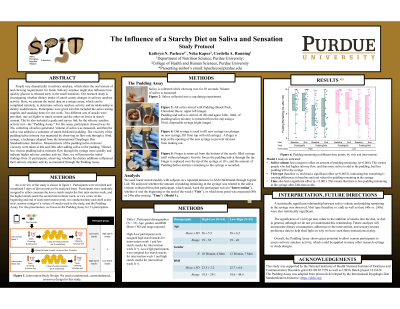Back

Objectives: People vary dramatically in the quantity and activity of their salivary amylase, which alters the oral texture of and chewing requirements for starchy foods. This study will investigate whether dietary intake of starch causes changes in salivary amylase activity, measured through an at-home assay. Additionally, we will test whether starchy diet and salivary amylase activity also correlate with sensory ratings of starchy and non-starchy foods.
Methods: Subjects are consuming 3 daily snacks that are relatively higher or lower in starch content. Subjects consume the snacks for 1 week, have a 1-week washout period, then switch to consume the other type of snack. At the beginning and end of each intervention week, data are being collected on smell/taste function, sensory attributes of the snacks, chewing behavior, and salivary amylase activity (measured through an assay conducted at home using a starch thickened pudding). Dietary records are being collected prior to starting the intervention, to gauge estimated average intake of starch at baseline.
Results: As this is a protocol abstract, results have yet to be obtained. However, we hypothesize that 1) after increasing dietary starch, salivary amylase activity will increase, 2) people with higher habitual starchy food intake will have increased salivary amylase activity at baseline, and 3) salivary amylase activity of those with higher habitual starchy food intake will change less in response to added dietary starch. We also expect that people who tend to prefer to “chew” vs. “crunch,” “suck on,” or “smoosh” their foods (from a mouth behavior assessment tool) will exhibit higher salivary amylase activity. Finally, we expect those with higher salivary amylase activity to show relatively higher/preferred sensory ratings for the starchy compared to non-starchy foods.
Conclusions: Data from this study will inform future work on how diet, salivary amylase, and sensory attributes/preferences in foods interact. It will also provide practical usage data on our in-home salivary amylase “pudding assay” tool.
Funding Sources: NIDCD R21DC017559, USDA Hatch Project 1013624
Protocols
(PO28-24-22) Study Protocol: Influence of Starchy Diet on Saliva and Sensation


Kathryn N. Pacheco, B.S.
– Graduate Student, Purdue University, West Lafayette, Indiana, United States- CR
Cordelia A. Running, MSc, PhD
– Assistant Professor, Purdue University, West Lafayette, Indiana, United States
Presenting Author(s)
Co-Author(s)
Disclosure(s):
Kathryn N. Pacheco, B.S.: No relevant financial relationship(s) with ineligible companies to disclose.
Cordelia A. Running, MSc, PhD: No relevant financial relationship(s) with ineligible companies to disclose.
Objectives: People vary dramatically in the quantity and activity of their salivary amylase, which alters the oral texture of and chewing requirements for starchy foods. This study will investigate whether dietary intake of starch causes changes in salivary amylase activity, measured through an at-home assay. Additionally, we will test whether starchy diet and salivary amylase activity also correlate with sensory ratings of starchy and non-starchy foods.
Methods: Subjects are consuming 3 daily snacks that are relatively higher or lower in starch content. Subjects consume the snacks for 1 week, have a 1-week washout period, then switch to consume the other type of snack. At the beginning and end of each intervention week, data are being collected on smell/taste function, sensory attributes of the snacks, chewing behavior, and salivary amylase activity (measured through an assay conducted at home using a starch thickened pudding). Dietary records are being collected prior to starting the intervention, to gauge estimated average intake of starch at baseline.
Results: As this is a protocol abstract, results have yet to be obtained. However, we hypothesize that 1) after increasing dietary starch, salivary amylase activity will increase, 2) people with higher habitual starchy food intake will have increased salivary amylase activity at baseline, and 3) salivary amylase activity of those with higher habitual starchy food intake will change less in response to added dietary starch. We also expect that people who tend to prefer to “chew” vs. “crunch,” “suck on,” or “smoosh” their foods (from a mouth behavior assessment tool) will exhibit higher salivary amylase activity. Finally, we expect those with higher salivary amylase activity to show relatively higher/preferred sensory ratings for the starchy compared to non-starchy foods.
Conclusions: Data from this study will inform future work on how diet, salivary amylase, and sensory attributes/preferences in foods interact. It will also provide practical usage data on our in-home salivary amylase “pudding assay” tool.
Funding Sources: NIDCD R21DC017559, USDA Hatch Project 1013624

.png)
